Rottweil is a medium-sized town located just outside the Black Forest region to the south of Stuttgart which proudly holds the title as the oldest city in Baden-Württemberg.
It is popular with visitors for its medieval centre, its towers (not all historic) and its fountains.
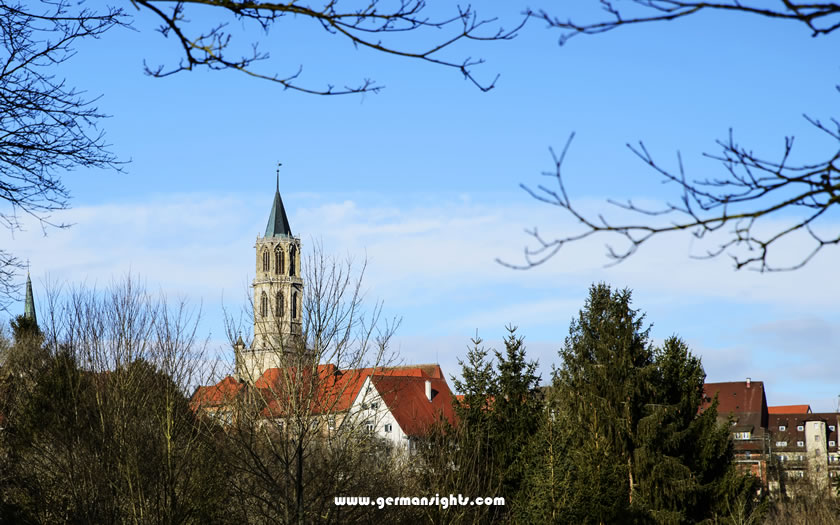
Rottweil in southern Germany
And, of course, it is the location that gives its name to the renowned breed of Rottweiler dogs, possibly dating back to the days of Roman settlement and their use for herding and guard duties.
The closest and most convenient airport for Rottweil is that at the state capital Stuttgart, followed by the major airport at Zurich.
Distance to Stuttgart Airport: 89km
Distance to Zurich Airport: 111km
Distance to Friedrichshafen (Bodensee) Airport: 116km
Distance to Baden Airport: 127km
Distance to EuroAirport Basel-Mulhouse-Freiburg: 152km
Those arriving by air might also want to see what options the smaller operations at Friedrichshafen and Baden-Baden might offer, although the choice of airlines and destinations at the two closer airports is likely to be much greater.
Rottweil is on an InterCity rail link between Stuttgart and Zurich so has good high-speed connections. It also links into the Black Forest rail network via Villingen. The train station is about a kilometre away from the historic centre up (or down) a steep hill.
Rottweil lies just to the east of the A81 motorway between Stuttgart and Lake Constance. It also has connections into the Black Forest centres of Triberg, Donaueschingen and Titisee by way of Villingen.
Rottweil is a sprawling town, although the historic centre is compactly located on a hill which rises steeply above the Neckar river.
If you know when you are planning to go but haven't decided on accommodation, then use the map below to get an idea of which properties are available and to compare prices during the period you wish to travel.
Enter your proposed dates and use the '+' to zoom in on a location and reveal more properties. Click on the price above a property to see more information.
(Please note that this selection will also include some pensions and self-catering apartments for those who are interested in that form of accommodation!)
Alternatively, if you would like a list of properties available on your proposed dates of travel, use the search box below to find accommodation:
Settlement in the area around Rottweil dates back to prehistoric times, but the history of the town really begins with the Romans arriving in the 1st century AD.
They founded a strongpoint known as Arae Flaviae which was the only Roman location to possess a town charter in the area from the Rhine through to Augsburg.
The settlement which later became Rottweil was situated in a strategic position at the junction of a number of trade routes - at the time it was one of the largest Roman towns in the area.
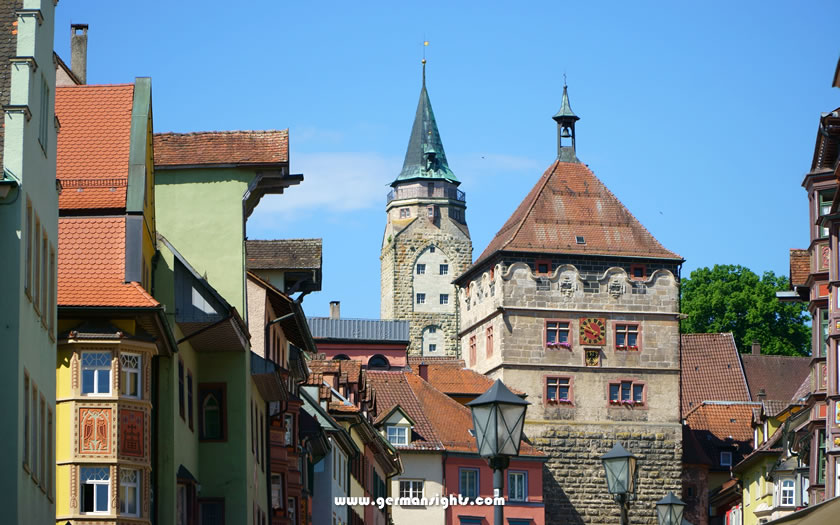
The Black Tower (Schwarzes Tor) at the top of the main street in Rottweil
Following the withdrawal of the Romans, their settlement declined until it became the site of a royal palace under the Germanic tribes with the name Rotuvilla (first mentioned in the 8th century). Under the Hohenstaufen rule it reached the heights of an administrative centre and court for the surrounding area and became a Free Imperial City in the 15th century.
In the 16th century it joined the Swiss Confederation, although it remained staunchly Catholic in contrast to its allies during the period of the Reformation. It was occupied a number of times during the various wars which plagued central Europe in the Middle Ages.
Rottweil became part of the state of Württemberg as part of the legal dissolution of the Holy Roman Empire at the start of the 19th century during the period of the Napoleonic Wars.
The town was connected to the rail system in Württemberg in 1868 and is nowadays an important junction with connections to Stuttgart, Zurich and the Black Forest.
These days, Rottweil is an administrative centre with an attractive old town of towers, churches and fountains.
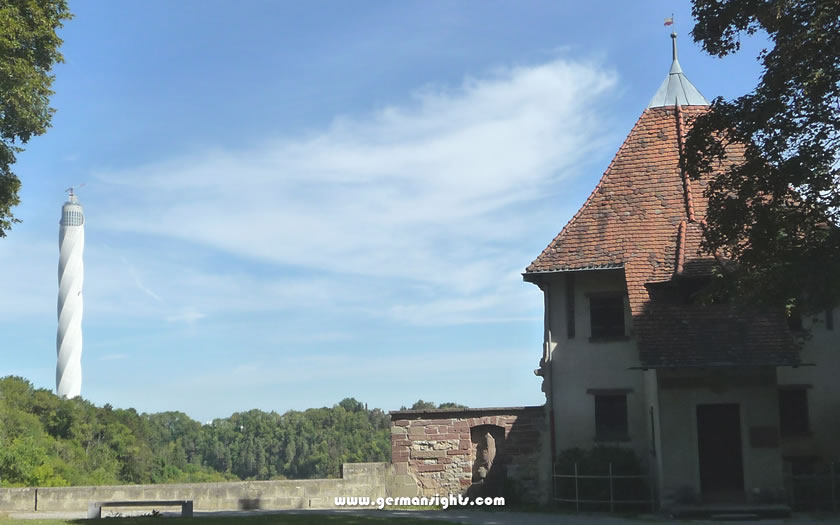
The historic Pulverturm and the modern ThyssenKrupp Test Tower near Rottweil
Another of the sights is more modern, with the construction of the ThyssenKrupp Test Tower in the nearby industrial area in 2017. The 246-metre tower was built for research into lifts (elevators) and has the highest viewing platform in Germany at 232 metres. It is open to the public from Friday to Sunday and occasionally on other dates during the summer high season.
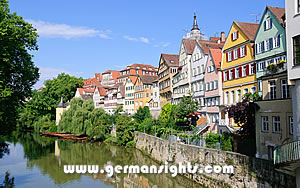
Tübingen dates back to the Middle Ages and is distinguished by its well-preserved old town featuring half-timbered houses and cobbled streets. Tübingen is also home to one of Europe's oldest universities, the Eberhard Karls University, established in 1477.
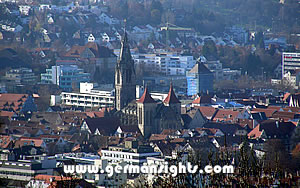
Reutlingen can boast several historical architectural sites from the Middle Ages, including its iconic town church, Marienkirche, and the imposing Tübinger Tor. It is located at the foot of the Swabian Jura and offers a blend of urban life and natural beauty.
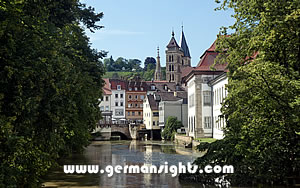
Esslingen is famous for its well-preserved medieval old town. The town is characterised by its half-timbered houses, majestic towers and the impressive Esslingen Castle. Once an influential imperial city in the Middle Ages, it is now known for its automotive and engineering industries.
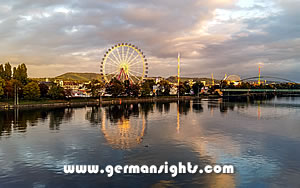
Stuttgart is a dynamic and diverse city in the heart of Baden-Württemberg. Founded in the 10th century, Stuttgart has transformed itself from a historic city into an automotive powerhouse, famously home to world-renowned car manufacturers such as Mercedes-Benz and Porsche.
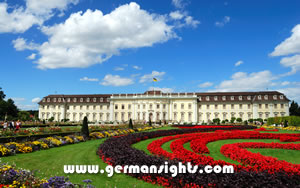
Founded in the early 18th century, Ludwigsburg is known for the Ludwigsburg Palace, one of the largest Baroque palaces in Germany surrounded by expansive, beautiful gardens. This city is also home to the Ludwigsburg Festival, a well-known international festival of music and performing arts.
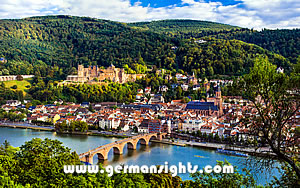
Heidelberg is home to Germany's oldest university, Ruprecht Karl University, founded in 1386. The city is synonymous with the iconic Heidelberg Castle, a mix of styles from Gothic to Renaissance, perched on a hill and overlooking the city and river below.
The tourist information office in Rottweil is located about halfway up the Hauptstrasse. It is open from Monday-Friday year-round and on Saturday mornings in the summer months.
Tourist Office: www.rottweil.de (German only)